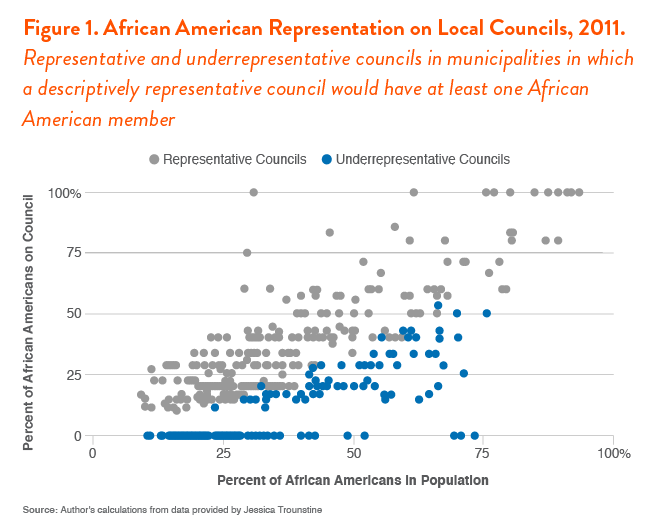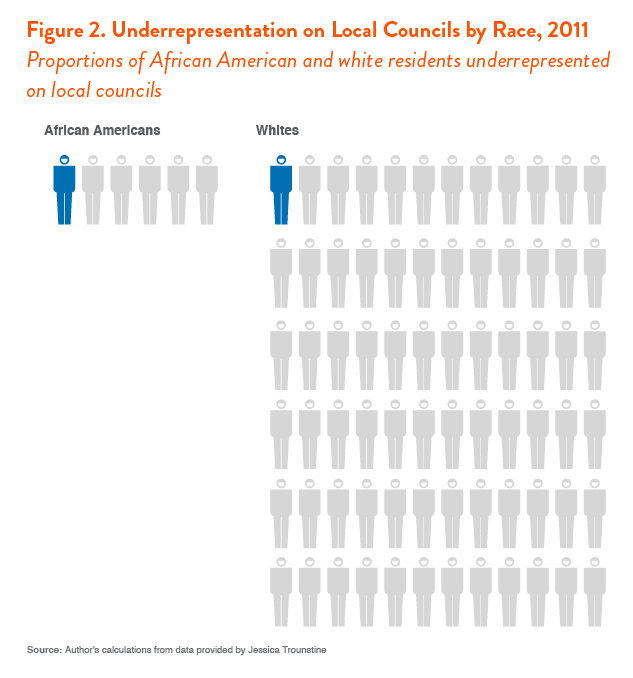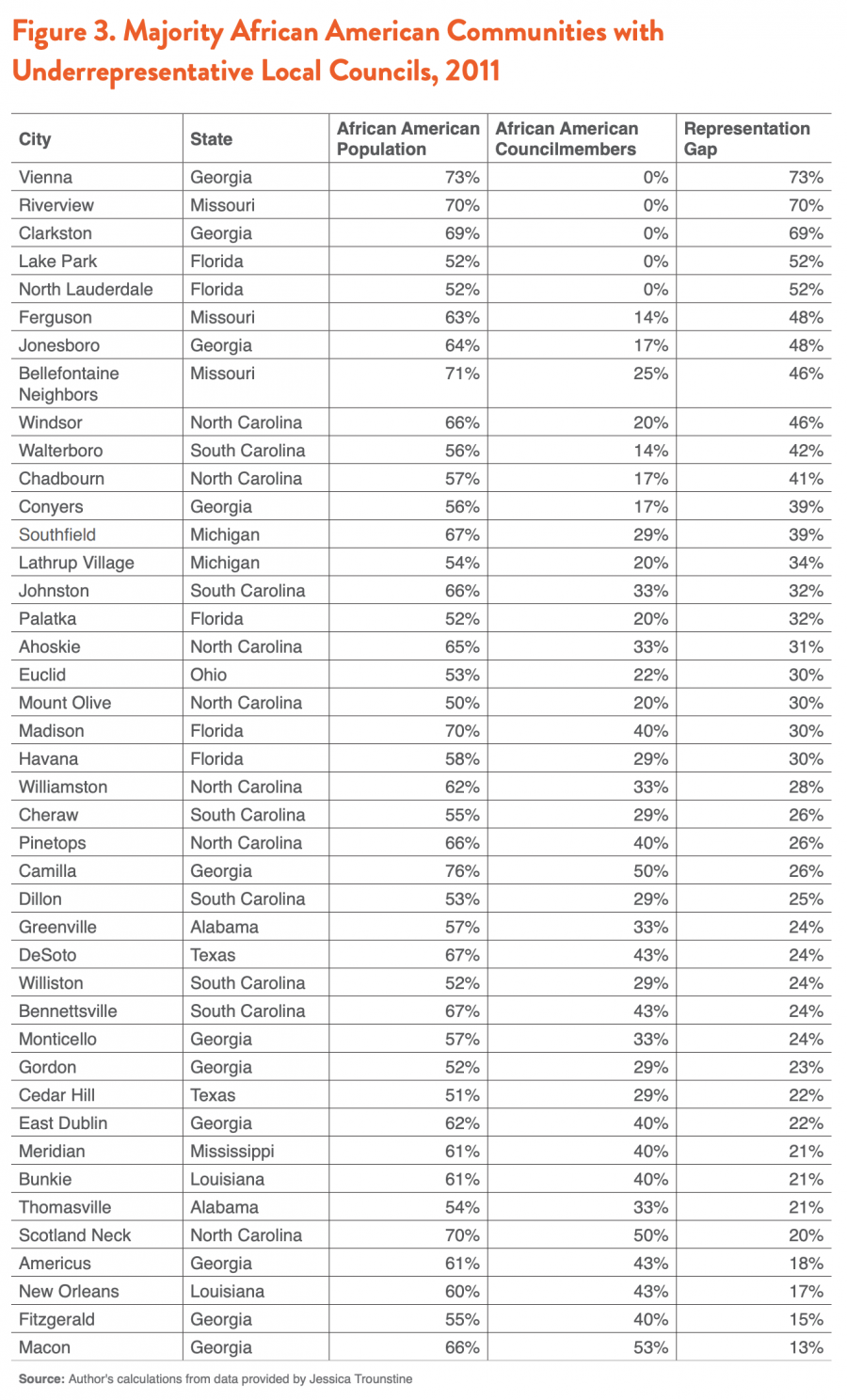The shooting death of Michael Brown in Ferguson, Missouri brought to light a set of racial injustices in the lived daily experiences of the city’s African American residents. Attempts to understand this deeper context of the unrest in Ferguson have drawn attention to the near all-white composition of its elected officials. Though African Americans make up about two-thirds of Ferguson’s population, they hold just one of the six seats on its City Council.
The gap between Ferguson’s residents and the officials elected to represent them is part of a larger pattern of African American underrepresentation in local government in the United States. More than 1.2 million African Americans in 175 communities across the country have councils that do not descriptively represent them. A council is descriptively representative if its members reflect the demographics of the community they’re supposed to represent. African Americans’ share of the council in these 175 communities does not reflect their share of the population.
The effects of this underrepresentation don’t always explode onto the national stage, as they did in Ferguson, but that lower profile shouldn’t be mistaken for insignificance. African Americans who are not descriptively represented are less likely to be engaged in the political process or have representatives who forcefully advocate their interests. That combination of disengagement and inattention fuels the cycles of injustice and mistrust that built to the sustained outrage and protests in Ferguson.
Who is underrepresented?
Ferguson has been pegged as an outlier but, though the representation gap in Ferguson is particularly pronounced, its basic story of African American underrepresentation plays out in many communities across the country. Of the 438 municipalities in which a descriptively representative council would have at least one African American member, 175 have councils that underrepresent their African American populations (see Figure 1). That leaves more than 1.2 million African Americans underrepresented by their local councils nationwide.

Underrepresentation at this level is an experience shared by comparatively few whites in the United States. Just over 500,000 whites live in communities in which their share of the population is not reflected in their share of seats on the local council.
And, though the gap between the absolute numbers of underrepresented whites and African Americans is striking, it doesn’t capture the full scope of the disparity. Whites outnumber African Americans 5-to-1 in the communities examined for this report so their smaller absolute numbers are also a smaller share of a larger total population. Just 1.5 percent of whites in the municipalities in the International City/County Management Association’s (ICMA) sample have local councils that don’t represent them. By contrast, 16.5 percent of African Americans in these municipalities are underrepresented. So, approximately one in every six African Americans lacks full representation on his or her local council, compared to just one in 66 whites (see Figure 2).

Particularly problematic is that many of the 1.2 million underrepresented African Americans live in communities in which they should have a powerful voice in local government. Almost a quarter of the municipalities with underrepresentative councils—home to close to half the total underrepresented African American population—have populations that are majority African American (see Figure 3). For residents of some of these communities, including the residents of Ferguson, the gap between their share of the population and their political representation is especially stark. Approximately 77,000 African Americans live in communities in which they make up more than half the population but hold only one or fewer seats on the local council.
Why does underrepresentation matter?
The intensity of the response to Michael Brown’s death reflects the steady build-up of scores of daily injustices. Those injustices are rooted in a deep disconnect between the African American residents of Ferguson and their city’s government. Descriptive representation fosters engagement between residents and their representatives, forging connections that promote policies and practices that reflect the lived experience of residents and are viewed by the community as fair and sensible.
Descriptive representation can be especially valuable in cities like Ferguson, where there’s limited trust between residents and their representatives, but it also seems to promote engagement more broadly. Studies show that African Americans tend to be more engaged with the political process when they are descriptively represented. They pay closer attention to elections and vote at higher rates when they are represented by an African American official and are more likely to run for offices that are or have been held by an African American.
In addition, African American officials tend to be more engaged with the African American communities they represent than their non-African American colleagues. Research suggests that African American legislators are more responsive to African American constituents than white lawmakers. They also advocate more forcefully for African American interests during the legislative process, proposing legislation and making speeches that promote African American interests at significantly higher rates than non-African American officials.
What causes underrepresentation?
The causes of African American underrepresentation are complex and often varied. One of the more robust explanations, explored in a burgeoning academic literature, traces underrepresentation to the way elections are run. Off-cycle election scheduling and nonpartisan ballots–both features of Ferguson’s City Council elections–have been linked to lower voter turnout. The electorate tends to get whiter as it shrinks and strong minority voter support is often critical to the success of African American candidates, so this combination of election rules can make it difficult for African American candidates to gain traction.
There are also other obstacles to African American representation—as Ferguson itself illustrates. As the research predicts, voter turnout in Ferguson’s 2013 City Council election was smaller and whiter than its turnout in the 2012 presidential contest. However, even if the electorate had been larger and more diverse, it would not have produced a more representative council in that particular election. African American incumbent Dwayne James won reelection to his Ward 2 seat but there were no other African American candidates for Ferguson voters to cast a council ballot in 2013. In Ward 3, where much of the city’s African American population is concentrated, white incumbent Keith Kallstrom ran unopposed.
One explanation for the shortage of African American candidates is the difficulty of being the first member of a demographic group to hold an office. As Paru Shah of the University of Wisconsin, Milwaukee notes, “black candidates considering running for office may be wary of entering races in which they would be the first to break representational barriers.” This may be a factor in Ferguson’s 3rd Ward. Despite the size of its African American population, Ward 3 has never had an African American representative on the City Council.
The nature of the job may also play a role. Councilmembers’ pay is often nominal—Ferguson pays its councilmembers a couple of hundred dollars per month—which limits the pool of potential councilmembers to residents with enough time and resources to serve on the council for little compensation.
The factors that tend to make it more difficult for African American candidates to win elections and the factors that tend to discourage them from running can also interact. According to Shah’s research, one of the main factors African Americans consider when deciding whether to run for office is the strength of potential minority voter support. The historically low African American turnout in Ferguson’s off-cycle, nonpartisan council elections might have discouraged some otherwise viable African American candidates from running for a seat on the Council in 2013. In other words, though low voter turnout didn’t prevent African American candidates from winning a Ferguson City Council seat in 2013, it might have prevented some from running for one.
In order fully to understand—and be in a position to address—the persistent underrepresentation of African Americans in the United States, it’s important to take both sides of the representation equation into account. A complete analysis of African American underrepresentation includes assessments of whether and why African American candidates don’t run for office, whether and why they don’t win when they do run and how these two sides of the representation equation interact. In an upcoming report, we will show how obstacles to African American candidacy and electoral success have contributed to underrepresentation in councils across the country.
Methodology
Data: The data for this report is based on the International City/County Management Association’s (ICMA) 2011 Municipal Form of Government Survey and was provided to Demos by Jessica Trounstine of the University of California, Merced. The ICMA survey was circulated to 8,813 municipalities, of which 3,566 responded. Demographic information was provided for 2,632 of these municipalities. The calculations in this report are based on these 2,632 municipalities.
The ICMA survey includes responses from a sample rather than the full catalogue of municipalities in the United States. As a result, the numbers in this report underestimate the total number of underrepresentative councils and underrepresented individuals in the country and should be viewed as minimums, or ‘floors,’ for underrepresentation. A full accounting of all municipalities would include many more underrepresentative councils and potentially millions more underrepresented individuals.
Descriptive representation: A council is descriptively representative if the demographic composition of its members reflects the demographic composition of the population it represents. In this report, we employ a conservative measure of descriptive representation. According to this measure, a council underrepresents a group if the group’s share of the council is equal to or less than its share of the population minus one councilmember’s share of the population. For example, a five-member council in a community that is 80 percent African American underrepresents African Americans if 60 percent or fewer of its members are African American. To be descriptively representative, this council would have to have four African American members.




